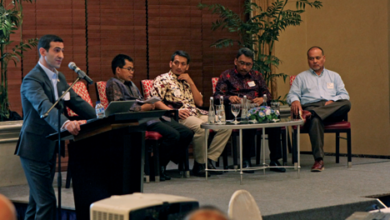BSEE, industry continue efforts to prevent bolt, connector failures on safety-critical subsea equipment
API workgroup has proposed actions to enhance quality control, failure reporting; industry continues engagement with BSEE to identify causes of failures
By Kelli Ainsworth, Editorial Coordinator

Beginning with a safety alert issued in February, the US Bureau of Safety and Environmental Enforcement (BSEE) has continued to place increasing attention on subsea bolt and connector failures in safety-critical subsea equipment. The regulator formed an Interagency Bolt Action team in July, then held a forum on 29 August in Washington, DC, dedicated to the issue. Through these and other investigative efforts, BSEE Director Brian Salerno said, the regulator hopes to gain a better understanding of the causes of bolt failures, how they might be related and how they can be prevented. “This is an issue that we have to understand and make sure that whatever corrective measures are identified are put in place,” Director Salerno told DC. “No one wants to run the risk of a catastrophic failure, and this is something we can get ahead of.”
Events reported so far
In December 2012, while drilling in the Keathley Canyon area of the Gulf of Mexico, the lower marine riser package (LMRP) on the Transocean Discoverer India drillship separated from the BOP stack due to a failure in H4 connector bolts. As a result, 432 bbl of synthetic drilling fluid were released into the Gulf. The release of the fluids triggered a reporting requirement, and BSEE was informed of the incident. As a result of the failure, the equipment manufacturer issued a recall for 10,000 H4 connector bolts that were in use worldwide.
According to BSEE, a total of 25 rigs in the Gulf of Mexico were impacted by the recall. Component change-outs that had to be carried out led to an average downtime of 17 days for each impacted rig.
By January 2013, BSEE’s Quality Control-Failure Incident Team (QC-FIT) had kicked off an investigation and started talking with various operators, contractors and OEMs about the bolt failures. The goal was to evaluate whether there was a risk for similar failures in the future and to develop recommendations to eliminate that potential. “It became apparent that the failure that we saw in 2012 was not a standalone event, that there were other events that had happened over the course of a number of years, going back to 2003,” Director Salerno said.
So far, BSEE has identified 10 incidents of bolt and connector failure in the Gulf of Mexico. However, the regulator emphasizes that it’s not certain that number is comprehensive. Failures may not have been reported if they did not trigger reporting requirements. “As this picture really started to come into focus, we realized that this may be a systemic problem that we need to address,” he added.
One of the other incidents that BSEE has identified occurred in June 2014. The BOP was on the rig’s deck for between-well maintenance when it was discovered that nine of 20 fasteners on the BOP’s hydraulic connector flange had failed. The regulator says it is also aware of instances where blind shear ram actuators have failed.
At this time, BSEE is still trying to determine the unifying cause that is contributing to these failures. “There could be any number of factors associated with this,” Director Salerno said. “It could be metallurgical specifications. We’ve looked at hardness, and we’ve looked at torquing requirements and specifications. There’s no single root cause that we’ve identified yet.”
The Intergency Bolt Action Team assembled this year includes NASA, the Department of the Navy, the Department of Energy, the National Laboratories and the Nuclear Regulatory Commission. Its goal is to search for an understanding of the problem and how it can be mitigated. Each of the participating agencies brings a particular specialty to the table, Director Salerno said. For instance, NASA has expertise in risk assessment, while the Nuclear Regulatory Commission deals with complex, highly technical systems similar to those found in the drilling industry. “These are experts that can look at the issue in a very systematic way to narrow down the likely list of possibilities for the root cause.”
So far, one of the major challenges for the team has been gathering sufficient data in order to understand the scope and potential causes of bolt and connectors failures. “Until recently, there was no requirement to report a failure of equipment, such as bolts, unless it was attached to an event that triggered a reporting requirement,” Director Salerno said. “There was really no way for us or anyone else to put the picture together.” If a failure didn’t trigger any reporting requirements, BSEE only learned of it either through discussions with the industry or through voluntary reporting.
That is about to change, with the Well Control Rule making it mandatory for all safety-critical equipment failures to be reported to the OEM and to BSEE. “That should improve the visibility of this problem,” Director Salerno said.
Determining the solution

Although BSEE and the industry are still working to understand the root causes of bolt failure, a few solutions are already being explored. “Part of what needs to be looked at are the current standards that are being used in the manufacturing of these bolts. We have to be sure the standards are correct,” Director Salerno said. It’s also important that the standards are followed during the manufacturing process and at every level in the supply chain.
Harmonization of standards could help, although that has its own challenges, said Bjørn Søgård, Segment Director of Business Development for Subsea and Wells at DNV-GL. “There are many standards. There are standards controlling the strength of the material without necessarily saying what type of material should be used,” he said.
“Then there are standards that say what type of material should be used. Then there are separate standards specifying what the manufacturing dimensions should be. Those standards have been created and are being maintained by other industries, such as the automotive industry. Clearly they have other objectives than what we need for subsea oil and gas. As an example, we need other requirements to materials than other industries. We need something in the oil and gas industry that pulls out the best and needed parts of those standards that we see to create something that’s useful for our industry.” Those needed adoptions are mostly taken care of through company internal procedures and specifications, Mr Søgård added.
In 2015, DNV-GL attempted to launch a joint industry project (JIP) focused on standardizing subsea bolts and connectors. While there were productive discussions, the JIP did not get off the ground. He attributed this partly to companies’ tendency to believe that internal processes or standards they follow are the best option; they also tend to be reluctant to adopt new standards. “If you believe you have a competitive edge because you have a better procedure than your competitor, you want to keep it,” he said.
At the same time, it’s hard to establish uniform standards when there is no clear understanding of the root cause of experienced bolt failures. “It can be hard to gauge if it’s a material failure, an assembly failure or if it has been over-torqued,” he said. Between designers, manufacturers and maintenance personnel, so many individuals can touch a bolt that it’s difficult to discern where the root cause of the failure occurred.
There are systems in place for quality control, but they might not always be followed all the way down the supply chain, said Brady Austin, Global QHSE Service Line Owner at Lloyd’s Register. The BSEE Well Control Rule now requires that manufacturers of critical components receive API Q1 certification, which will raise the standards followed by manufacturers.
Still, because there are so many layers of suppliers and sub-suppliers, not all levels in the supply chain are always properly assessed. “Operators or contractors have to verify that things are being done as they’re supposed to be done,” Mr Austin said. “You have to conduct periodic performance evaluations all the way down the chain.” This means that operators need to go beyond making sure their suppliers are complying with regulations; they also must comply with contractual obligations, management system requirements and appropriate industry practices. This includes every supplier of a service or every component of a piece of equipment, like a BOP.
Third parties can be brought in to help operators, contractors and OEMs conduct audits of their suppliers. They can also help companies assess and identify gaps in their own quality management systems. For instance, Mr Austin said, time pressures can lead to a company not strictly following the guidelines of their own quality management system.
“Even though your management system requires you to go and assess your suppliers or their subcontractors, you kind of have a stake in the game,” he said. “You’re likely to have some level of bias in making sure you get these bolts no matter what.”
But it’s not just quality control that needs to be examined. John Hoefler, Vice President of Drill Through Equipment Services at Lloyd’s Register, said the industry should review every aspect of bolting, beginning with design. “We have to try to design parts that don’t require high-strength bolting,” he said. “Once the component begins to be manufactured, we need to guarantee the manufacturing process and procedures are performed correctly and with the proper quality control and third-party participation to ensure biases are avoided and objectivity is ensured.”
Industry collaboration

Because of the potential for a catastrophic event associated with bolt and connector failures, BSEE and the industry have a shared interest in understanding the cause and possible solutions, Director Salerno said. “We have to work in unison to solve this,” he said. “I feel pretty confident that the industry feels the same way.”
In 2015, API formed a multisegment task group made up of operators, contractors, manufacturers, classification societies and service companies. The group met bi-monthly throughout that year to identify potential failure mechanisms and to look for potential solutions, Eric Milito, API’s Group Director for Upstream and Industry Operations, said at the 29 August BSEE forum. This group developed 20 recommendations relating to various API standards relating to bolting, including plans for ironing out any conflicts that existed between standards.
“Safety is our industry’s core value, and our members are leading the charge to identify areas needed to stay on top of safety through regular and rigorous inspections,” Mr Milito said. “We are working diligently with BSEE and other stakeholders to enhance operations as necessary. We also use advanced procedures and technologies for continued safe development as the United States leads the world in oil and natural gas production.”
After BSEE issued the safety alert on bolt failures in February, API then formed a workgroup of more than 50 experts that has met with BSEE in both March and June of this year. In July, the workgroup developed a list of proposed actions for addressing bolt failures, including enhanced quality control and assurance of bolting and enhanced failure reporting with wider distribution.
In August, BSEE responded to API’s recommendations, stating that they were in line with key areas that BSEE had identified as needing action. The regulator also expressed its intention to work closely with industry committees, standards organizations and subject matter experts to address the issue.
“We remain engaged with API’s workgroup, and we’re very pleased that they are doing that,” Director Salerno said. “Going forward, we’re asking the industry to take seriously the need to report instances so we have as much visibility around the problems as we can possibly get, because that will aid everyone who’s looking at the problem in determining what the root causes are and identifying the likely solutions.”
In its August letter to API, BSEE requested that the group encourage its membership to share any data or studies relevant to the issue directly with BSEE or through the SafeOCS program.
While bolts may seem like small and insignificant components, they can have a major impact on safety-critical equipment. They have been compared to O-rings, also a small component, which caused a catastrophic failure in the space shuttle Challenger. “We have not had a (catastrophic) incident, but let’s not be lulled into the false sense of security that this very simple component is so simple that it’s not going to cause a problem,” Director Salerno said. DC
Click here to view BSEE’s safety alert for bolt and connector failures.
Click here to visit SafeOCS, BSEE’s confidential near-miss reporting system.




